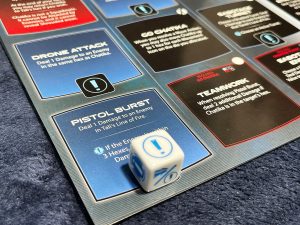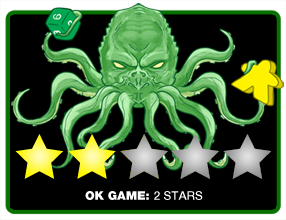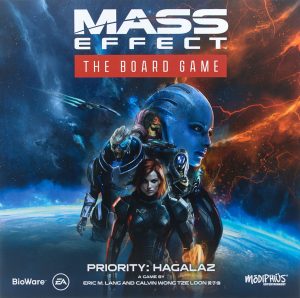 Regular readers of the site will know that I’m a big fan of video game translations on my tabletop. Well, I’ll say that with the caveat of only when it’s done right. Back in the day, they used to be nothing but a licensed IP slapped on a mediocre game (at the best of times). But we are in a new age now. With games like Frostpunk: The Board Game, 6: Siege – The Board Game, and Assassins Creed: Brotherhood of Venice, publishers and designers are really taking the time to create experiences that do justice to their source material.
Regular readers of the site will know that I’m a big fan of video game translations on my tabletop. Well, I’ll say that with the caveat of only when it’s done right. Back in the day, they used to be nothing but a licensed IP slapped on a mediocre game (at the best of times). But we are in a new age now. With games like Frostpunk: The Board Game, 6: Siege – The Board Game, and Assassins Creed: Brotherhood of Venice, publishers and designers are really taking the time to create experiences that do justice to their source material.
The newest entry in the category is Mass Effect: The Board Game – Priority: Hagalaz. Designed by veteran game designer Eric Lang, along with Calvin Wong Tze Loon 黃子倫, Mass Effect drops you in the shoes of Commander Shepard and other squadmates from the SSV Normandy as you take on threats from the Reapers and Cerberus.
Gameplay Overview:
Mass Effect: The Board Game is a short campaign game played over a series of 5 branching missions. Each mission requires Commander Shepard and 3 other squadmates (regardless of player count).
At the start of a player’s turn, they roll all of the available dice (12 for the first player in a round) and then select 3 to use. Dice will allow you to move your characters, or activate an ability such as attacking or hacking. Moving is pretty straightforward, allowing your character to move to an adjacent hex for each icon spent. However, moving out of an enemy’s threatened area will trigger an opportunity attack.

In addition to the move and ability icons, there is also a Star icon. When that is rolled during the roll dice step, the character gets to use its unique power, and then reroll it. This may allow Tali to move her drone, or Wrex to flip a rage token (for example).
Combat is handled by using a character skill, usually inflicting a couple of points of damage on an enemy in a direct line of sight. A character can attack any unit that you can draw a straight line from one of your 6 hex sides (no turning) and is not blocked by cover or walls. Damage is automatic and most enemies (outside of elites) have 2-3 health points.
At the end of your turn, you reveal your hazard card, which will usually spawn and/or activate a specific enemy type. When an enemy activates, they deal you damage if they are adjacent to you (or have a range icon), if not, they will move 2 spaces towards you. Any damage taken is first done to your shields, and then to your health once your shields are depleted. However, shields do recharge fully at the end of each round.
Then the next player goes. They are allowed to lock 1 unused die result from the previous player (if desired) before rolling all the rest of the dice and taking their turn.
The game ends either when the mission is complete or when Commander Shepard has been defeated.

Game Experience:
Do you know the feeling when you were a little kid and Christmas morning finally arrived (or your gift-giving holiday of choice)? There are tons of presents waiting to be unwrapped and you eagerly tear into them. And finally… you get to that one package with the sparkly wrapping paper and elaborate bow that you’ve been eyeing for weeks! You open it up and your excitement immediately deflates as it turns out to be a new pair of underwear from your grandmother. Yeah, that kind of sums up my feelings on the Mass Effect Board Game.
I’m a huge Mass Effect fan. I’ve played through the trilogy twice, and even suffered through Mass Effect Andromeda (for some reason). So, obviously, I was geeked about getting a chance to control Commander Shepard (Femshep is canon in my opinion thanks to the amazing voice acting by Jennifer Hale), Liara, Wrex, and others from the Normandy’s crew.

And the designers actually did a good job of drawing some of the video games theme into the board game. Garrus is a great sniper, Tali is a master technician, and Wrex is a Krogan beat stick. I also liked how each mission had two possible endings, you could either take the Paragon path or the Renegade path. Even the way the shields work brought me back to the video game and hunkering down behind a waist high wall waiting for it to recharge.
The dice mechanics were also kind of clever, in that the first player gets to roll 12 dice and chooses three, and each remaining player gets 3 fewer to roll. It does create a bit of tension as the player at the end of the round has to make do with what they have. It’s a bit on the random side, but with only 2 icons (For the most part), early players in a round can usually roll what they need. I also liked that you can save an unused die result from the previous player’s roll, at least banking something you might need.

Yet that’s where things start to fall apart because the combat system just kind of stinks. More specifically, the enemy cards dump a constant stream of bad guys on you, and, while I love map books for dungeon crawlers, these battlefields feel super tight. More enemies will spawn after almost every player’s turn, which can turn the game into a grind. And thanks to the line of sight rules, half of the time you can’t even shoot a close enemy. You need to first spend a move action to move around so they are directly in a line from you, and then spend another die to actually shoot.
Now I will say things do open up a bit as you unlock skills when you level up (which is pretty easy), but that doesn’t really take all the frustrations away. That’s because action spaces are also limited. Tali only has 1 shoot space, so on her turn, if she is swarmed by enemies, she gets off 1 rather weak shot and that’s it. There were times when she really had nowhere to move, so she made one attack and had to waste her other two dice because there was literally nothing for her to do with it. I feel like if you are going to have the randomness of action dice, then you can’t also limit how many of each you can use. Doing both creates some really frustrating turns.

I was hoping a loyalty mission would spice things up a bit, but those are pretty weak as well. For example, Tali needs to hack some terminals for her mission, and she’s the only one who can do it. Yet she only has 1 hack action space. So you need to get her to a terminal and spend a turn sitting on it to hack it. Then spend another turn sitting on it to hack it, and then repeat that on the other side of the map. Meanwhile, the other players are just wandering around shooting enemies. Wrex’s was similar. Once the Krogan boss spawns, only he can do full damage to it. So everyone else just hangs out killing enemies, while Wrex just stands in one space doing the same thing over and over.
I was actually pretty excited about the dice mechanics when I was reading the rules, but in practice, it only kind of worked. Going first in a round, you are rolling 12 dice and will almost always get the icons you need. But for the last player, it’s basically a crapshoot on if you will be able to use a full turn. You are only rolling 3 dice (with no rerolls), so if you happen to roll all move icons, well you won’t be shooting that round and there is not much you can do about it.

I feel like the Mass Effect Board Game isn’t sure what kind of game it wants to be. The dice limitation on action spots and the restrictive line of sight rules make it seem like it’s the type of game where it’s not about combat, but focusing on mission objectives (like Batman: Gotham City Chronicles or Legends of Andor). Yet the tight maps, the fact that you take opportunity attacks from breaking away from enemies, and the constant spawning of minions means you can’t just kill a select few and head for the objectives.
Finally, I hated the loss condition. If Shepard goes down, it’s game over. I know that mirrors the video game, but you also have a ton more control there. It’s very possible that your character will be attacked multiple times before you even get to act again. The lack of player agency here really dragged down the experience. In the end, Shepard felt more like a liability that needed to be protected and we ended up hiding her in the back when things got dicey.
Final Thoughts:
Because of Eric Lang’s pedigree, I had really high hopes for Mass Effect: The Board Game – Priority: Hagalaz. Cthulhu: Death May Die is one of my top 5 games of all time, and Marvel United is a game I admittedly own way too much of. Yet Mass Effect: The Board Game feels like a wasted opportunity. The characters are interesting, but the nuts and bolts of the gameplay (especially the combat) are not. By mission 2 we were already trying to think of house rules that could make combat more enjoyable, but in the end, the game just wasn’t all that fun.
If you are looking for a great Mass Effect experience on your tabletop, this isn’t it. There is some potential here for a fun game, but it got drowned out by the grindy, unsatisfying combat rules.
Final Score: 2 Stars – A game I really wanted to like that I don’t ever want to play again.
 Hits:
Hits:
• Characters feel on point to the lore
• Enjoyed having both Paragon and Renegade mission options
Misses:
• Grindy combat
• Lack of action spaces on characters dashboards limits what you can do
• Line of sight rules are too restrictive
• Commander Shepard is a liability and can lose you the game
Source: Board Game Quest





